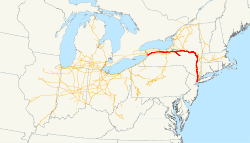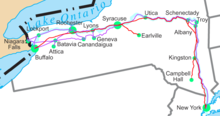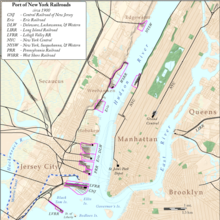- West Shore Railroad
-
- This article is about the line of the New York Central Railroad system. For the current short line railroad near Milton, Pennsylvania, see West Shore Railroad (Pennsylvania).
West Shore Railroad 
West Shore Railroad (red) and New York Central system (orange) as of 1918Locale Weehawken, NJ to Buffalo, NY Dates of operation 1872–1885 Track gauge 4 ft 8 1⁄2 in (1,435 mm) (standard gauge) The West Shore Railroad was the final name of a railroad from Weehawken, New Jersey, across the Hudson River from New York City, north along the west shore of the river to Albany, New York and then west to Buffalo. It was organized as a competitor to the New York Central and Hudson River Railroad, but was soon taken over by that company.
Contents
History
 Map of the Water Level Routes of the New York Central Railroad (purple), West Shore Railroad (red) and Erie Canal (blue)
Map of the Water Level Routes of the New York Central Railroad (purple), West Shore Railroad (red) and Erie Canal (blue)
The first part of the line was built as the Saratoga and Hudson River Railroad, incorporated April 16, 1864 and opened in Spring 1866. After only about a year of independent operation, the line served as a branch of the New York Central Railroad, splitting at Athens Junction near Schenectady and running southeast and south along the west side of the Hudson River to Athens. Early plans included acquiring the Saratoga and Schenectady Railroad as a northern extension. The Saratoga and Hudson River was bought and merged into the New York Central as their Athens Branch on September 9, 1867. The terminal at Athens was destroyed by fire in 1876. The line ran intermittently from then into the 1880s, with its tracks being torn up for good in 1888. It had been called the "White Elephant" Railroad for most of its existence because it quickly outlived whatever usefulness it may have had. Today a row of brick houses known as the Brick Row Historic District which was built in 1850 for the workers of the failed railroad stand in Athens as the only remaining structure related to the "White Elephant" Railroad project.
At the south end of the route, the Ridgefield Park Railroad was incorporated April 4, 1867. This was planned as a branch of the New Jersey Rail Road, splitting at Marion Junction and running north on the west side of the New Jersey Palisades via Ridgefield Park to the state line at Tappan, New York. Across the state line, the Rockland Central Railroad was incorporated May 23, 1870 to continue the line to Haverstraw, and the Rockland Central Extension Railroad, incorporated May 29, 1872, was to continue further north along the west side of the Hudson River. The Rockland Central and Rockland Central Extension merged on July 29, 1872 to form a new Rockland Central Railroad, and that company merged with the Ridgefield Park to form the Jersey City and Albany Railroad on June 24, 1873, with the intention of building a full line from Jersey City to Albany.
The line first opened in 1872 as a spur of the New Jersey Midland Railroad, which had built the section south of Ridgefield Park. At that time, the northern terminus was at Tappan; the extension north to Haverstraw opened in 1879.
Bankruptcy struck soon, and the New York section of the line was sold on September 28, 1877 and reorganized October 12, 1878 as the Jersey City and Albany Railway. The part in New Jersey was sold August 17, 1878 and reorganized with the same name, and the two companies merged in January 1879 (January 25 in New Jersey and January 28 in New York) to form a consolidated Jersey City and Albany Railway.
The North River Railway was incorporated April 3, 1880 to continue the built line north to Albany with a branch to Schenectady and a connection to the New York, Ontario and Western Railway at Cornwall. (The Hudson River was also called the North River.) The North River Railway was consolidated with the Jersey City and Albany on May 5, 1881 to form the North River Railroad, again forming a single planned line between Jersey City and Albany.
The Hudson River West Shore Railroad was incorporated February 16, 1867, and the West Shore Hudson River Railroad was incorporated October 28, 1867, absorbing the Hudson River West Shore on February 16, 1867. This was a second proposed line on the west shore of the river from New Jersey to Albany. The New York, West Shore and Chicago Railroad was incorporated July 13, 1870, and absorbed the West Shore Hudson River on July 21, 1877, with a planned line not only to Albany but then west along the south bank of the Mohawk River to Buffalo. That company was sold and reorganized as the New York, West Shore and Buffalo Railway on February 18, 1880, and on June 14, 1881 the North River Railroad was merged into it, forming one company in charge of the whole route from New Jersey to Buffalo.
The company leased the Athens Branch of the New York Central and Hudson River Railroad, the old Saratoga and Hudson River Railroad, and incorporated it into their main line between Coxsackie and Fullers. At Ravena, along the Athens Branch, the main line turned northwest towards Schenectady, while a new branch continued north to Kenwood Junction on the Albany and Susquehanna Railroad in Albany. At the south end, a new alignment was built along the east side of the New York, Susquehanna and Western Railway (formerly the New Jersey Midland) to North Bergen, where the new alignment turned east into the Weehawken Tunnel under the Bergen Hill, ending at Weehawken Terminal. This full line opened January 1, 1884, forming an immediate threat to the New York Central's monopoly.
In addition to its owned trackage, the West Shore also had trackage rights over the Suspension Bridge and Erie Junction Railroad and Erie International Railroad, providing a route from Buffalo to Ontario. After the New York Central took over the West Shore, this was useless, as the New York Central had a parallel line, the Buffalo and Niagara Falls Railroad.
The West Shore also had relations with the Boston, Hoosac Tunnel and Western Railway, which would have run from the Hoosac Tunnel in Massachusetts west to Buffalo. Instead the BHT&W built only to Rotterdam Junction west of Schenectady; it was later taken over by the Fitchburg Railroad.
In 1881 the West Shore had been planned as a link in a new cross-country line from New York to San Francisco, using the New York, Chicago and St. Louis Railway (Nickel Plate Road), Chicago, Milwaukee and St. Paul Railway, Northern Pacific Railroad and Oregon Navigation Company. However, William Henry Vanderbilt of the New York Central had bought the Nickel Plate in 1882, killing that plan. The New York Central then proceeded to drive the New York, West Shore and Buffalo into bankruptcy. The Pennsylvania Railroad realized that the West Shore would make a great addition to their system, allowing them to penetrate deep into New York Central territory. At the same time, the New York Central was building the South Pennsylvania Railroad across southern Pennsylvania, the Pennsylvania Railroad's territory. The two railroads came to an agreement, where the New York Central would buy the West Shore and stop building the South Pennsylvania (sections of which were later used for the Pennsylvania Turnpike). The New York Central bought the New York, West Shore and Buffalo Railway on November 24, 1885 and reorganized their new acquisition as the West Shore Railroad on December 5, immediately leasing it for 475 years from January 1, 1886.
Life as a New York Central line
In many sections, the West Shore ran on a straighter path than the New York Central, and was thus used for through freight. For instance, between Oneida and Utica, the West Shore followed the general line of the never-built Syracuse and Utica Direct Railroad, which had been merged into the New York Central.
Part of the West Shore around Schenectady was used as a freight bypass, both to keep through freight out of Schenectady and to avoid steep grades on the main line. To access this, two connections, known collectively as the Schenectady Detour, were built on each side of Schenectady. The Hoffman's Connection opened in 1900, connecting the New York Central main line at Hoffman's, west of Schenectady, southeast to the West Shore; this allowed trains bound for New Jersey to bypass Schenectady and Albany. The Carman Cut-Off opened in 1902, running from the New York Central main line at Carman, east of Schenectady, southwest to the West Shore, completing the bypass. The new route was 1.16 miles longer but saved time.
The Hudson River Connecting Railroad, also called the Castleton Cut-Off, was incorporated in 1913 and opened in 1924, providing a full bypass for the New York Central around Albany. This new route split from the West Shore southwest of Albany, at Unionville, ran southeast to cross the West Shore's Albany Branch at Selkirk onto the Alfred H. Smith Memorial Bridge. From there the line split, with one branch turning south to merge with the New York Central at Stuyvesant, and the other continuing east to a merge with the New York Central's Boston and Albany Railroad at Post Road Crossing. This latter branch became the B&A's Post Road Branch.
End of passenger service on the line
Passenger service on the line was discontinued in 1959, ending direct train service on the west side of the Hudson River to Albany, New York. The line now serves as CSX Transportation's principal freight route from Western points to the Metro New York City area (New Jersey), via the former NYC Selkirk Yard, southwest of Albany, New York. [1]
Relations with the New York, Ontario and Western
The New York, Ontario and Western Railway started out as the New York and Oswego Midland Railroad, running from Oswego on Lake Ontario southeast to the New Jersey border at Unionville, where the New Jersey Midland Railroad continued to Jersey City. After the reorganization in 1880 of the New York and Oswego Midland (and the New Jersey Midland), the newly-organized New York, Ontario and Western built a new route in New York, from the old route at Middletown east to Cornwall on the Hudson River. The opening of the West Shore in 1884 gave the New York, Ontario and Western trackage rights from Cornwall south to Weehawken, which it kept through the reorganization and buyout by the New York Central.
Road condition
By 1974, the roadbed was in good condition and there was little evidence of flooding, landslides, or encroachments over the entire length. Portions of the right-of-way were slightly overgrown, but generally it was visible and was in good condition. Around the village of Solvay in the vicinity of Allied Chemical, the right-of-way was not visible because there were so many operating tracks in the area that it was impossible to pinpoint the right-of-way. The right-of-way was evident, however, from Warners, New York west.[1]
Most tracks, ties, signal facilities, bridges and depots have been removed, however, some overpasses remain around Palmyra and Newark. These were put in by farmers to get to adjacent fields. The right-of-way, however, was still in operation near Newark, Macedon and Egypt in order to serve local customers on the line.[1]
The terrain through which the right-of-way passes is generally flat. This is in part due to the fact that the right-of-way parallels the old Erie Canal. The principal land use of abutting properties is varied. From Syracuse to Warners it passes through commercial and residential development in the villages and towns.[1]
The right of way is in close proximity to several major highways including Route 31.[1]
Along the west side of the Hudson River the former West Shore line is operated as the River Subdivision of CSX Transportation.
Branches
- Montgomery
- Athens and Fullers
The branches from Coxsackie south to Athens and from Fullers northwest to Athens Junction were part of the original Saratoga and Hudson River Railroad.
- Albany
- Earlville
- Buffalo Creek
See also
- Highland Falls Railroad Depot, former West Shore station building on the National Register of Historic Places (NRHP)
- Milton Railroad Station, also on the NRHP
References
- ^ a b c d "Inventory of Abandoned Railroad Rights of Way". New York State Department of Transportation, 1974. http://russnelson.com/inventory/inventory-of-abandoned-railroad-rights-of-way-region-3.html. Retrieved February 18, 2011.
- Railroad History Database
- The New York, West Shore and Buffalo
- New York Central Historical Information
- West Shore Railroad
- Another New Railroad Completed, New York Times March 19, 1866 page 5
- City and Suburban News, New York Times May 2, 1874 page 12
- General Railway Notes, New York Times June 15, 1880 page 5
- Extensive Railroad Projects, New York Times August 4, 1880 page 5
- A New Line to the West, New York Times November 5, 1881 page 8
New York Central Railroad subsidiaries 1850s 1853: Auburn Road · Falls Road · Schenectady and Troy · Buffalo and Lockport. 1854: Lewiston. 1855: Buffalo and Niagara Falls · Rochester and Lake Ontario. 1858: Niagara Bridge and Canandaigua1860s 1869: Hudson River.1880s 1882: Nickel Plate. 1885: West Shore.1890s 1900s Categories:- Predecessors of the New York Central Railroad
- Defunct New Jersey railroads
- Defunct New York railroads
- Erie Canal
- Hudson River
- Railway companies established in 1885
- Railway companies disestablished in 1952
- Weehawken, New Jersey
- Transportation in Hudson County, New Jersey
- Transportation in Rockland County, New York
- Defunct railroads in Syracuse, New York
Wikimedia Foundation. 2010.


